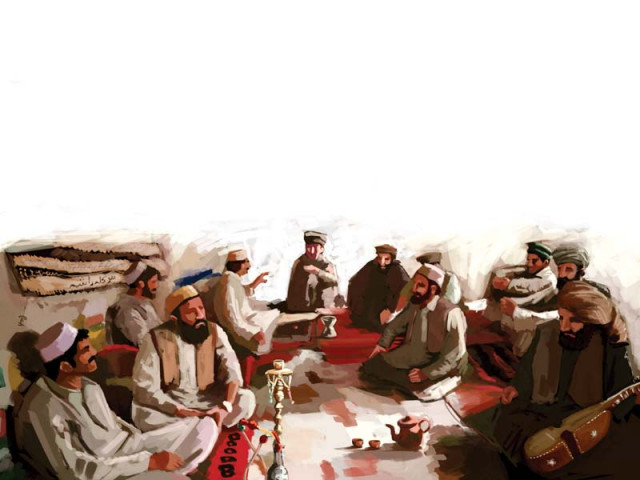Hujra: Where boys used to become men
Hujras were the equivalent of the sewing circle — not any more.

Hujras were the equivalent of the sewing circle — not any more. ART BY JAMAL KHURSHID
A few yards away, teenagers are lolling back on charpoys or squatting by them, playing cards in the shade of an old tree. Discreet smiles are exchanged from time to time as a village scandal quietly rolls off someone’s tongue. A little further ahead, a few middle-aged men sip tea and exchange thoughts on the Afghan drawdown while reminiscing about the good-old days. Preparations are underway for the night time tappay (singing) session as someone tunes the rabab strings. In the background, the caretaker, Kakhay, is keeping a watchful eye. The sense of community in the hujra is as real as the men sitting there.
In the veranda right below, “Har kala rasha” is written on a wall. It loosely translates to “May you always come,” in the Khyber-Pakhtunkhwa region and is a phrase that usually indicates the space you are entering is a hujra.
A community club of sorts, found in almost every village and mohallah, the hujra is an integral part of Pakhtun culture. Usually shared by the whole community, it may sometimes be a space owned by a person of means, normally an open area stretching up to 1,200 square yards. Most hujras have a clearly marked boundary but no door, signalling that everyone is welcome. While lively conversations dominate the course inside the hujra, the open terrace adjacent is occasionally used for communal gatherings such as funeral prayers or wedding ceremonies.
Popularly known as a hujra or daira in Khyber-Pakhtunkhwa, it has been given various names throughout Afghanistan as well, ranging from kotta in Kabul, a sarachah in Khost, jammah in Dera Ismail Khan and chawk in Lakki Marwat.
Qazi Hanifullah, a teacher of Pakhtun culture for nearly 20 years at the University of Peshawar, explains that the hujra is an institution where men learn about life. Everything, from sensitive subjects such as sexuality, emotional and psychological problems to bigger issues such as succeeding in life, is discussed openly by the men who come from all ages and backgrounds.
However, with the spread of popular technology and the rampant use of cell phones and computers, the hujras are gradually losing their usual crowd. While the older generation still congregates in these spaces, it has become almost impossible to attract the youth here.
In Hanif’s opinion, this was slowly causing an erosion of Pakhtun culture. “The younger generation knows what is happening in Bollywood or Hollywood but no one is willing to listen to the poet who published his latest book,” he said. “They would know about the latest hairstyle but have no clue why the colour of a woman’s bangles changes as soon as she gets married. They don’t know these things because they are just not interested anymore.”
There are others who believe that while it is not necessarily worrying that the younger generations want to keep up with the rest of the world, there is a risk of losing touch with your own roots. Salma Shaheen, a researcher and professor of Pushto literature, said that while hujras still survive as a building in almost every village of Khyber-Pakhtunkhwa, they are losing importance as an institution.
“Almost 80% of Pakhtunwali (the Pakhtun code of conduct) is related to hujras,” she explains. “Therefore, a decline of the institution means a decline in Pakhtunwali.”
Comparing it to practices from the British era, Shaheen adds that the Pakhtunwali code was not written down but preserved through word of mouth and practice. A hujra is the only place where these traditions are learnt, acted upon and then passed on to the following generation.
“Unfortunately, the former generation couldn’t pass on this tradition to the current one and I am afraid the next generation would merely know the word, but not its importance,” she says.
In urban areas such as Peshawar, Charsadda, Mardan, Swabi and Nowshera, hujras are also being demolished and replaced by more modern structures. Shah Nawaz Ghamgeen, a resident of Jamrud, takes pride in his vibrant hujra which has survived all odds, including a militant bombing, and is still host to a daily congregation of the village tribesmen.
In most areas, the modern drawing room seems to have replaced the hujra in terms of utility. But for seasoned elders such as Ghamgeen, the collective experience of good company and conversation is hard to replace.
Published in The Express Tribune, Sunday Magazine, October 13th, 2013.



















COMMENTS
Comments are moderated and generally will be posted if they are on-topic and not abusive.
For more information, please see our Comments FAQ